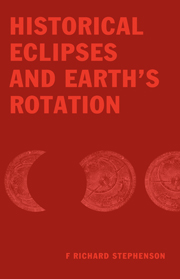Book contents
- Frontmatter
- Contents
- Principal Symbols
- 1 Variations in the length of the day: a historical perspective
- 2 Tidal friction and the ephemerides of the Sun and Moon
- 3 Pre-telescopic eclipse observations and their analysis
- 4 Babylonian and Assyrian records of eclipses
- 5 Investigation of Babylonian observations of solar eclipses
- 6 Timed Babylonian lunar eclipses
- 7 Untimed Babylonian observations of lunar eclipses: horizon phenomena
- 8 Chinese and other East Asian observations of large solar eclipses
- 9 Other East Asian observations of solar and lunar eclipses
- 10 Records of eclipses in ancient European history
- 11 Eclipse records from medieval Europe
- 12 Solar and lunar eclipses recorded in medieval Arab chronicles
- 13 Observations of eclipses by medieval Arab astronomers
- 14 Determination of changes in the length of the day
- Appendix A Timed data
- Appendix B Untimed data
- References
- Acknowledgements
- Index of eclipse records
- Index of places of observation
- Name Index
- Subject index
2 - Tidal friction and the ephemerides of the Sun and Moon
Published online by Cambridge University Press: 13 November 2009
- Frontmatter
- Contents
- Principal Symbols
- 1 Variations in the length of the day: a historical perspective
- 2 Tidal friction and the ephemerides of the Sun and Moon
- 3 Pre-telescopic eclipse observations and their analysis
- 4 Babylonian and Assyrian records of eclipses
- 5 Investigation of Babylonian observations of solar eclipses
- 6 Timed Babylonian lunar eclipses
- 7 Untimed Babylonian observations of lunar eclipses: horizon phenomena
- 8 Chinese and other East Asian observations of large solar eclipses
- 9 Other East Asian observations of solar and lunar eclipses
- 10 Records of eclipses in ancient European history
- 11 Eclipse records from medieval Europe
- 12 Solar and lunar eclipses recorded in medieval Arab chronicles
- 13 Observations of eclipses by medieval Arab astronomers
- 14 Determination of changes in the length of the day
- Appendix A Timed data
- Appendix B Untimed data
- References
- Acknowledgements
- Index of eclipse records
- Index of places of observation
- Name Index
- Subject index
Summary
Introduction
In order to determine the value of ΔT from an eclipse observation, it is necessary to be able to calculate accurately the positions of the Sun and Moon at any selected epoch. By definition, the Sun has negligible acceleration on TT. However, the longitude of the Moon contains an appreciable quadratic term – part of which (owing to the reciprocal action of the tides) can only be determined empirically. Since many of the eclipses recorded in history are remote from the present-day, the effect of the lunar accelerative term on their calculated visibility is substantial. Furthermore, knowledge of the tidal component of this acceleration (usually denoted by ṅ), leads directly to a determination of the effect of the tides on the Earth's spin – see section 2.4. Consequently, it is important to investigate both the numerical value of ṅ and its constancy during the historical period. Each of these questions will be considered in the immediately following sections (2.2 and 2.3).
Evaluation of the lunar tidal acceleration on TT
As discussed in chapter 1, the gravitational component of the lunar acceleration (coefficient of T equal to 6″.05) is well established. Up to about 1970, all estimates of the non-gravitational lunar acceleration were based on analyses in a UT framework. Results for the secular acceleration of the Moon (c) and Sun (c′) on UT can be easily converted to ṅ using the formula:
- Type
- Chapter
- Information
- Historical Eclipses and Earth's Rotation , pp. 33 - 42Publisher: Cambridge University PressPrint publication year: 1997



